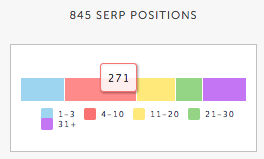In digital we are obsessed with measurement and data; there are hundreds of ways to collect stats on how websites perform and how users are interacting with each site. Collecting and visualizing data is extremely important for users, SEO agencies, digital marketing companies, and any business that wants to strive on the digital world.
It becomes easy to be blinded by data and hit a wall of numbers. However, data is only useful if you can extract insight from it that will help drive your business forward.
The best way to do this is to streamline the information you’re looking at to be only the most relevant and useful figures to your overall business goals. By filtering out the noise, you can effectively identify the metrics that matter and make strategic business choices backed by accurate data.
So, just how do you pick the right metrics for your business in this world of data overload?
Organic Rankings
The simplest measure for understanding your organic performance is to track your ranking positions across targeted keywords. However, this data is very granular and can lead to those with a more top-level view getting caught up in the detail.
Google continually tests and changes ranking positions by a couple of places so the data is subject to external fluctuations.
Several factors, including the time and location of a rank check, can skew the image you see. Instead, we’d recommend looking at your rankings hand in hand with a couple of other metrics to really see the full picture.
Keyword Position Spread
Keyword Position Spread – The Keyword Position Spread of a site shows the distribution of the keyword rankings across each position in organic search.
To get a clearer overview of your rankings, beyond individual positions, a keyword position spread chart will enable you to see how you do across all terms. It is fairly typical for a site to have significantly more terms in positions 31+ than they do on the first page of the search results so you should see each category increasing in size as you get further from position 1.

This chart enables quick insight into the immediate SEO opportunity of a site. Lots of keywords in positions 11–30 are referred to as ‘low-hanging fruit’ as often a few small SEO tweaks can lead to these moving onto the first page of results – leading to a significant increase in click through rate and visibility.
A site with a fundamental technical integrity issue, or internal cannibalisation of content, will frequently see that it struggles to rank for any terms on the first page of the search results.
This is an initial warning sign that performance may be hindered by something much deeper on the site and a full audit is required. Rock Content Search has a page flux filter which allows you to identify and monitor cannibalisation issues:

Number of Ranking Pages
Number of Ranking Pages – The number of unique URLs which appear in the top 100 rankings positions for any keyword.
Alongside looking at the number of keywords, and their rankings, it’s important to also understand the value of all of the pages on your site. A well-architected site, with efficient crawling and keyword targeting, should see all of their pages performing for the appropriate keywords.

Compare the number of ranking pages your domain has, to the number of pages which appear in Google.
A large difference should raise concerns that either the site is over-indexed or there is a reliance on a very small percentage of pages in organic search as equity is not flowing around the site correctly.

These simple metrics can be used alongside individual keyword rankings to get a clearer picture of how a domain is performing organically. It enables a better understanding of where these rankings are coming from, and what the bigger picture is beyond just a few focus keywords.
This is essential for tracking the progress of an SEO campaign.
Competitor Comparison
As a business, you do not operate in isolation, which means that understanding the performance of competitor sites is also key. Utilising public metrics to gain insight into how a competitor’s website is performing can act as a benchmark for your own performance, and help you to identify new opportunities.
CTR
Click-Through Rate (CTR) represents the percentage of users who clicked on a link to your site from the SERP. Typically, the higher a result is positioned on the SERP, the higher the chance that a user will click on it.
Lots of research has been done on the average rate at which users click-through to pages based on their position. In Rock Content Search, you can setup your own CTR models to get an idea of how much traffic you or your competitors might be getting based on your rankings. For example:

For an even more accurate view of CTRs, you can integrate your Google Search Console account with Rock Content Search to see for each page and keyword, exactly what your average CTR is based on real world rankings data split into mobile, tablet and desktop.

Estimated Traffic
Estimated Traffic – This metric takes the total search volume for a keyword against the typical click through rate for that position ranking to estimate the volume of organic traffic a domain is earning.
It’s simple to compare your own organic traffic month on month to understand your SEO performance with all the data collated in Google Analytics.
However, how do you know how you’re doing compared to your competitors? Estimated Traffic enables a broad overview of how much traffic your competitors may be taking in organic search; which is especially valuable when compared to your own organic traffic and multiple other competitors estimated traffic to understand your market share.

Universal Results
Universal Results – Universal Results is a term which describes any rich results in organic search e.g. video, maps, knowledge graph boxes, these tend to appear at the top of the page and increase a site’s click through rate.
One of the elements which help a site gain a higher click through rate, and reflects the strong technical integrity of the domain, is the number of universal search results which are owned by that domain.
Site’s with strong levels of authority around a topic will often be used by Google to provide richer results, with images or video in search on certain keywords. If universal results are being displayed on a search term, it is an opportunity for you to develop your website further to provide the best information and take ownership of this prominent organic position.

To successfully analyse competitor performance, track the number of universal results on each keyword which is significant to your business and identify which brands are owning these results. This insight will inform a content strategy for video production, structured data blogs, and your Google My Business implementation.

Product/Service Launch
While these metrics are essential to making sure your website is thriving, they also provide data-driven insights for when you plan to launch any additional products or services on it.
SEO metrics and the data that your site collects can help you to establish the size of the market you’re trying to develop into, and the level of competition within it.
Traffic Opportunity
A very niche product or sector will have a significantly lower search volume in total, which can make it harder to break into if there are already existing businesses.
Or it can mean that your marketing strategy needs to focus on demand generation, rather than supplying the pre-existing audience. To understand the type of the market you’re moving into in terms of search, the total search volume for related terms can be a good metric:

The sum of all related keywords to your new sector added together will provide a total Traffic Opportunity, which is a rough estimate of the size of the market in organic search. Understand this in relation to the products and services you already provide to see how large the opportunity you’re entering into is.
Media Value
Media Value – Media Value is the sum of all PPC AdWords spend around the selected group of keywords.
Whilst we’ve focused on organic search, the Media Value can also be extremely valuable and indicate user interest in a product – which then will impact upon the SEOstrategy you use.

If the Media Value is high on the keywords which you are analysing, it indicates that competition within that sector is high. It also shows that the terms are converting well for the businesses which are already operating in that sector as it is unlikely for brands to be spending high amounts on terms which do not generate them direct revenue.
If you’re an agency or part of an in-house SEO team, traffic opportunity and media value can also be useful metrics for pitching to a new client or making a business case for a stronger focus on SEO to senior decision makers.
The metrics covered here are just a small selection of ones which can provide insight into website performance. They demonstrate how different metrics are important to each business, depending upon the objectives they are trying to meet.
The most important part of tracking is to be able to take that data and convert it into real, actionable insights to impact your business.
Written by Richard Faderin, Product Marketing Manager, Rock Content Search

Richard is a Product Manager at Rock Content, working closely with users of the platform to understand their needs and desires and make improvements to Rock Content Search. He has a background in Logistics and User Experience Design and has held a number of Product and Marketing roles at technology companies based in London.








